The feeder crossed underneath Bolton Road near the junction with Fairy Street; notice the cast iron bridge parapet nearby carrying the Bury coat of arms.
The canal feeder then ran almost parallel to Bolton Road but behind the rows of houses on Hulbert Street, Proctor Street and Dearden Street. There is no real sign of its route along here now.
However, if you turn left off Bolton Road opposite Fairy Street, onto Fountain Street, and follow it to the right towards the back of Daisyfield Court, you will find the stonework pictured below. |
|
This is the top of the entrance to a tunnel which carried a siding from the Bury to Bolton railway to deliver coal directly into the corporation gas works between Ainsworth Road and Victoria Street.
The gasometers there are still in use though the works site itself has recently been cleared.
The canal feeder would have been just to the left of the tunnel. |
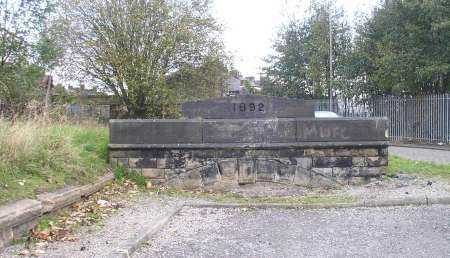
The tunnel entrance is dated 1892. A kink in the canal feeder at this point was straightened out to make room for the railway line.
|
|
The feeder continued through Bury Corporation Tar Distillery (in 2007 being redeveloped for housing) and in a cutting behind what is now Dearden Fold and Buller Street. It passed under the later Bury to Bolton railway (opened in 1845) near the bridge leading from Buller Street to the former Florence Nightingale Hospital site. |
|
By following the unnamed road (possibly it is a continuation of Hinds Lane) past the Florence Nightingale site towards Elton Reservoir, the feeder can be seen emerging from a culvert on the right hand side just beyond the bridge over the cycle track. It then follows the road as little more than a trickle at the bottom of this deep ditch most of the way to the reservoir. |
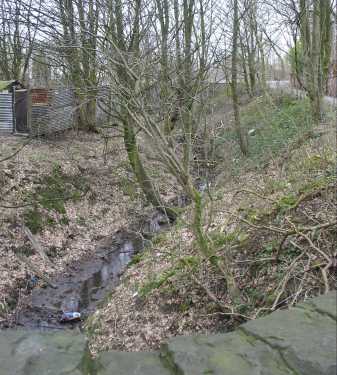
|
|
Shortly before reaching Elton Reservoir there is a footbridge across the canal feeder with a small weir and a black metal control box nearby, as seen in this photograph. |
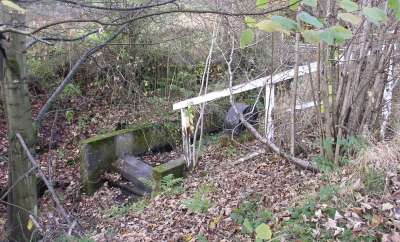
|
|
| | OS Map Ref SD 790 098 |
Finally the canal feeder joins Elton Reservoir.
Elton Reservoir covers 54 acres and is up to 24 feet deep. it holds 150 million gallons of water. |
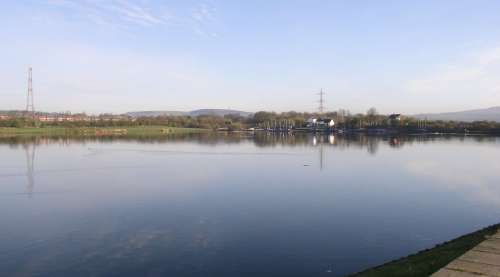
View looking across Elton Reservoir towards the canal feeder inlet and Elton Sailing Club
|
|
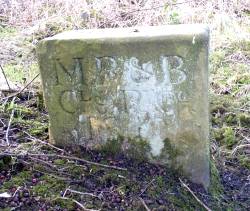 By the 1830s many railways were being constructed and looked set to replace canals as a means of goods transport. The Manchester, Bolton and Bury canal company thought of turning itself into a railway company and even considered filling in the canal and running a railway line along its route. In the event it seems the company was legally obliged to keep the canal open and a separate railway was built, between Manchester and Bolton by 1836 and Manchester to Bury by 1846. The railway line (formerly the East Lancashire Railway then the Lancashire and Yorkshire Railway and now the Metrolink) does in fact run close to the canal between Bury and Radcliffe.
By the 1830s many railways were being constructed and looked set to replace canals as a means of goods transport. The Manchester, Bolton and Bury canal company thought of turning itself into a railway company and even considered filling in the canal and running a railway line along its route. In the event it seems the company was legally obliged to keep the canal open and a separate railway was built, between Manchester and Bolton by 1836 and Manchester to Bury by 1846. The railway line (formerly the East Lancashire Railway then the Lancashire and Yorkshire Railway and now the Metrolink) does in fact run close to the canal between Bury and Radcliffe.
Evidence of the move into the railway business is seen on this stone, hidden amongst bushes to the southwest of where the canal feeder joins Elton Reservoir.
The lettering says M B & B CL & RY CO 1840, standing for 'Manchester Bolton and Bury Canal and Railway Company'. |
|
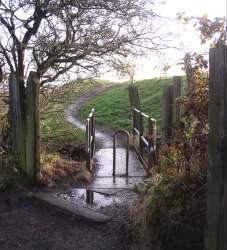 From the point where the canal feeder flows into Elton Reservoir, follow the unsurfaced road heading South East past Elton Sailing Club. Just past the sailing club take the footpath on the right, over the narrow metal bridge across a channel (right), and up onto the embankment of Elton Reservoir.
From the point where the canal feeder flows into Elton Reservoir, follow the unsurfaced road heading South East past Elton Sailing Club. Just past the sailing club take the footpath on the right, over the narrow metal bridge across a channel (right), and up onto the embankment of Elton Reservoir.
|
|
This embankment, on the eastern side of the reservoir, was the location of a "Great Trespass" in 1902. The Lancashire and Yorkshire Railway Company (who owned the canal at that time) tried to prevent walkers strolling along the top of the embankment but the barriers were pulled down by several local people.
Eight men were summoned to appear before Radcliffe Magistrates for malicious damage, however the court decided they had merely asserted their legitimate claim to a right of way and acquitted them.
Then the railway company tried to obtain an injunction against the eight at Manchester Assizes to stop them removing any future barriers. Again the jury found in favour of the men.
Next the L & Y R went to the Royal Courts of Justice in London, and lost again, and finally the company appealed to the House of Lords. After deliberation the Lords upheld the earlier decisions.
The "Eight Men of Radcliffe" became local heroes and were presented with specially struck medals.
|
|
![]()